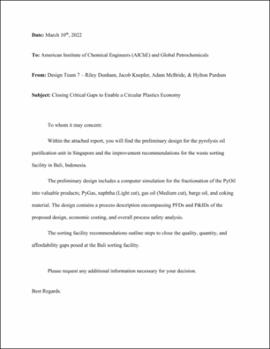| dc.contributor.author | Dunham, Riley | |
| dc.contributor.author | Knepler, Jacob | |
| dc.contributor.author | McBride, Adam | |
| dc.contributor.author | Purdum, Hylton | |
| dc.date.accessioned | 2023-05-12T21:38:13Z | |
| dc.date.available | 2023-05-12T21:38:13Z | |
| dc.date.issued | 4/18/2023 | |
| dc.identifier | oksd_dunham_aiche_national_design_competition_2023 | |
| dc.identifier.uri | https://hdl.handle.net/11244/337688 | |
| dc.description.abstract | Global Petrochemicals and AIChE requested the design, optimization, and economic evaluation of a PyOil purification plant and recommendations for improvement of a sorting facility in Bali as well as recommendations to increase participation in waste management in the region. | |
| dc.description.abstract | The design of the PyOil purification plant had two major sections: A fractionation section of the plant where PyOil feed would be split into PyGas, a Light Cut, a Medium Cut, Barge Oil, and potential coking products; and a purification section of the plant where the Light Cut and Medium Cut would have contaminants removed. The Light Cut and Medium Cut products will be utilized as feed for a steam cracker in an ethylene plant, the PyGas as fuel gas in the ethylene plant, and the Heavy Cut split into two products for the sake of creating new profitability for the process. The plant was designed to operate continuously and was designed with spare equipment so that production upsets would not stop production of products or cause off specification production. Overall, the design was evaluated to cost $19.6 million in capital cost, $1.99 million per year in variable cost, and $4.35 million per year in fixed cost. | |
| dc.description.abstract | When looking at how to improve the sorting facility and community involvement, three critical gaps were sought to be closed with possible new solutions which would also take steps toward solving the plastic waste issue. It was sought to close gaps in Quality, Quantity, and Affordability with recyclable waste collection process in Bali. To solve the quality gap, a three-bag system would be introduced to shift sorting responsibility from the waste collection company to the households. With an increase in the quality of waste sorting, the quantity gap would close as a greater separation of waste entering the waste facilities would also mean that the facility would be capable of greater throughput of recycled products. The quantity gap would also be closed with a cooperative program to encourage households to recycle more often because of an incentive system that would compensate participating households at the end of every year. Both the quality and quantity gap solutions would help close the affordability gap by minimizing cost for waste management facilities in Bali with a lower labor cost per waste delivered. | |
| dc.format | application/pdf | |
| dc.language | en_US | |
| dc.rights | Copyright is held by the author who has granted the Oklahoma State University Library the non-exclusive right to share this material in its institutional repository. Contact Digital Library Services at lib-dls@okstate.edu or 405-744-9161 for the permission policy on the use, reproduction or distribution of this material. | |
| dc.title | AIChE National Design Competition: Closing critical gaps to enable a circular plastics economy | |
| osu.filename | oksd_dunham_aiche_national_design_competition_2023.pdf | |
| osu.accesstype | Open Access | |
| dc.type.genre | Honors Thesis | |
| dc.type.material | Text | |
| thesis.degree.discipline | Chemical Engineering | |
| thesis.degree.grantor | Oklahoma State University | |
